ALL-TROUT 2007: The Invisibile Trail
Minaret Lake
Agnew Meadows Trailhead to Ediza Lake to Minaret Lake to the Devil’s Postpile Trailhead
August 18 – 21, 2007
Andrei, Charles, Steve
The Map
This is a map of the journey, created by Charles using ArcMap software by ESRI in Redlands, California. Click on the map to enlarge.
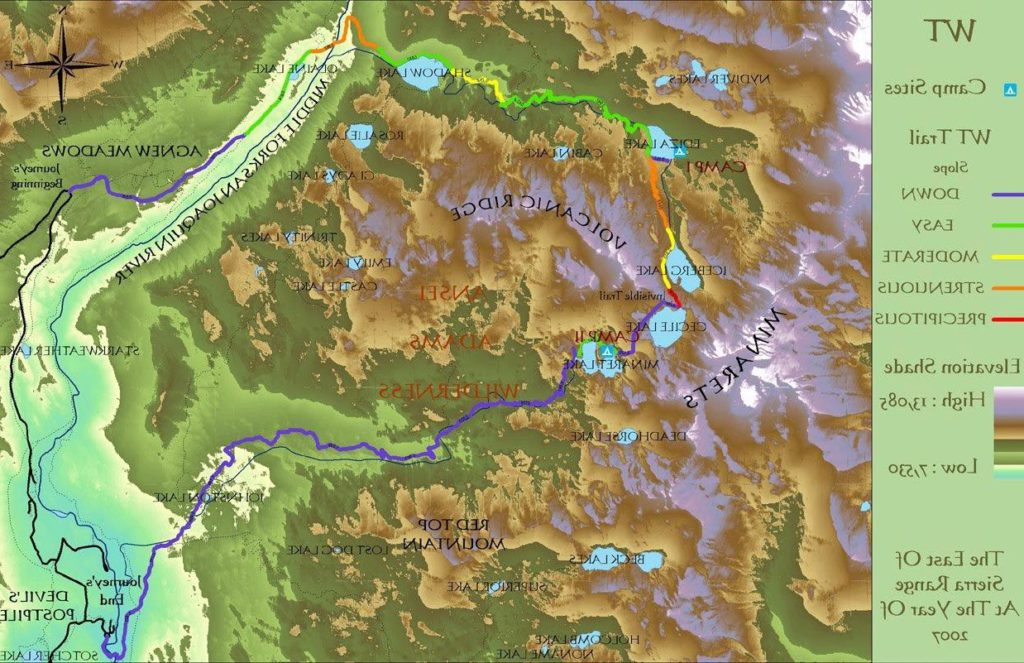
Prologue
I write this on the shore of one of the Sierras’ gems, Minaret Lake, enjoying one of the finest days witnessed by this writer, his companions, and perhaps all of the backpackers who have journeyed through this haven. Charles flyfishes, ankle deep in the lake’s sapphire waters, as Andrei naps in his tent. A squirrel, carrying a nut or other prize, has climbed the tree next to me, and sits at the base of a broken branch, enjoying the spoils of his never-ending quest for food.
The sometimes absent, sometimes firm, but commonly moderate breeze keeps us at a perfectly enjoyable temperature, all the while under the unblemished, deep blue sky, which serves not only as the canvas upon which the mighty Minarets are painted, but also as our portal to the outer reaches of our galaxy, appearing nightly as the Milky Way presents herself in a manner impossible at the lower altitudes of our civilized world.
And the Minarets! They can not be mentioned in passing, but then again could fill a book 10 times the size of this one, if described properly. This writer will do the best he can, although he proceeds haltingly, uncertain of his ability to give them their due. They tower around us for a full 180 degrees, creating the basin in which our beloved lake rests, sometimes towering to great height and coming to impossibly narrow pointed peaks, and sometimes bulking outward in more rotund and massive fashion, a display which for this writer gives rise to a notion that the Minarets are the guardians of the Sierras, or at least the guardians of the Cecile, Iceberg and Ediza lakes which we know from experience lie behind them. The glacial snow and occasional gravity-defying trees which adorn the Minarets serve both as a break from the massive boulders, loose shale, and multi-colored rock faces which comprise the mountains themselves, but also as a scale which gives us the ability to more accurately gauge the size of these massive giants which stand watch over our camp.
Charles has caught a fish (a brook trout, which Charles has sent back to its business), the squirrel has left to continue his quest, and Andrei has arisen from his slumber to embark upon a circumnavigation of the lake, a visit to neighboring Dead Horse Lake, or perhaps just a jaunt to the outlet of our lake and a view of Mammoth’s valley, and perhaps Owens Valley and even points beyond.
So, too, must this writer progress to a recounting of our travels thus far, as difficult as it is to leave this most beautiful and enjoyable setting, which presently was punctuated by the appearance of a hawk, flying over us at no more than thirty feet, giving us a view of his outstretched wings and his gray and white stripes.
But this description provide thus far, while it does not memorialize the outset of our adventure, does serve to inform you, dear reader, that we did not only survive the Invisible Trail, but we conquered it as well.
Day 0: The Pre-Trip
My trip began as it always does, with the long drive out of San Diego, up Interstate 15 and over the Cajon Pass (where I acquired a cheeseburger and fries, as a final send-off from civilization or at least “civilized” food), then on to the 395 to watch as the small communities of Olancha, Lone Pine, Big Pine, Independence and Bishop glide by my window.
I had a nice chat with my mom via cell phone, which has become an enjoyable tradition as part of my journey. I listened to John Cheever stories through my iPod. I thought. And, intermittently, I received phone-call updates from Charles, who was heading out from Ventura with Andrei. They reached Mammoth a few hours ahead of me, but the timing worked out nicely, as they took care of their food shopping (and sunglasses for Charles), and conjured up a pizza, salad and beer for our dinner, which we enjoyed down in our campsite in Agnew Meadows.
I had never camped down in Mammoth’s valley, but had previously admired its beauty. Our campsite was no exception – we ate dinner in the shadows of a dense pine forest with a view of Agnew Meadows beyond. The pizza was excellent and the cold beer was welcome after a day’s travel, but it was the company of friends that was the best of all. We stayed up perhaps too late, but ultimately retired for some good sleep.
strong{ text-align: center;display: block;}
p{text-align:left}
.has-text-align-center{text-align:center}
img{text-align:center !important}
Base Camp at Agnew Meadows
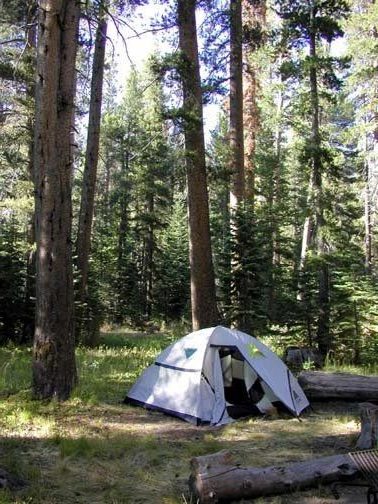
Day 1: Agnew Meadows to Ediza Lake
Ah, how wonderful it is to start the morning with the smell of bacon, which combines with the sounds of
popping and crackling in the pan as a banquet for the senses! Unfortunately for us, the bacon belonged to
the people camping next to us, as did the popping, the crackling, and the magnificent odor. We settled for an
energy bar and an orange. We also had some aloe juice, but not as much as we would have had if Charles
hadn’t inadvertently spilled half of it into Andrei’s brand new hat, filling it like a bowl of soup.
By the time we struck camp, loaded our packs, and positioned our cars at both the Devil’s Postpile and the
Anew Meadows trailheads, it was 11:00 before we began or march. Not as early as we’d hoped, but
everything worked out beautifully. We reached Shadow Lake at 1:00, after first traversing along the waterfalls
created by its outlet. Shadow Lake was every bit as beautiful as Charles and this writer remembered from
their visit some five years prior. Lunch along a log at the far end of the lake, near the inlet, was perfection
itself. The beautifully fine weather (which has plagued us this entire trip) presented itself in force, prompting
us to cast off our shirts to further enjoy the sun. There was a curious but welcome absence of mosquitoes.
This writer ate his usual (tuna on a bagel, with Taco Bell hot sauce, while my comrades enjoyed a
smorgasbord of crusty French bread, sliced salami, cheese and nuts.
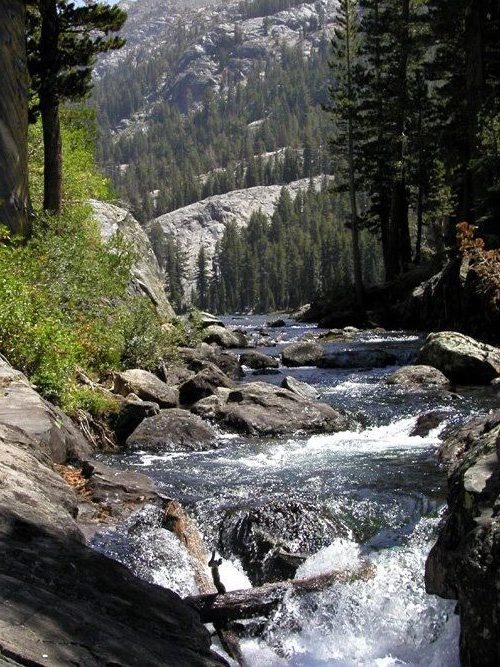
After our break, it was off to the unknown – Ediza Lake, which none of us had visited previously. The walk
was remarkable. An easy, gradual ascent, alongside the stream that flows from Ediza to Shadow. In all, it
was about 3 or 3.5 miles from Shadow Lake to Ediza Lake, and 7 or 7.5 miles for the day, but this last stretch
was not difficult at all.
While we weren’t tired during our hike, we became so almost immediately upon our arrival, so that even
locating our campsite seemed like a task. We finally settled on a site near the inlet (or one of the inlets, as
there are a few), not too far from a small falls which supplied our water. Ediza Lake is a very pretty lake, and
this writer looks forward to returning (perhaps to try a campsite on the “right” side of the lake, as one is
approaching from below). We dined on freeze-dried rations of kung pao chicken and curry chicken, neither of which was remarkable. There was also some celebratory tequila (with limes). This writer is not ashamed to
admit he grew somnolent directly after dinner (if not before) and was in bed by 8:00, and asleep after reading
a few pages of “20,000 Leagues Under the Sea.”
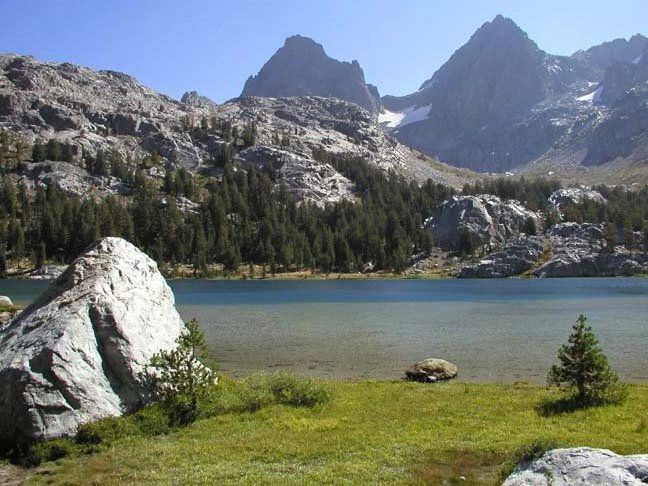
We had a breakfast that was neither leisurely nor rushed, following a night of sleep that was long but
disturbed by strong winds. Breakfast, as usual, consisted of instant cereal (Cream of Wheat for this writer,
and oatmeal for Charles and Andrei), freeze-dried fruit, and coffee. There is no doubt that the breakfast
discussion related to the trail ahead of us. The word “trail” is used loosely here, because the USGS map
doesn’t show our route. Then again, I wouldn’t call our trek truly a cross-country venture, as the trail was
patent, with the exception of a few noteworthy lapses which will be explained. The backpacker’s book we
relied on for hints in planning the trip used words like “precipitous” and “for experienced hikers only” to
describe our route. I do not think it unfair or inaccurate to point out that Charles manifested the most outward
signs of any trepidation we shared.
Our initial climb, from beautiful Ediza to Iceberg, was strenuous but uneventful, with beautiful views of Ediza
and her surrounds behind us. Iceberg was a deep lake of smallish size, with a few stands of diminutive trees
sharing its alpine basin. It was not the beauty of the lake that enraptured us, but instead the “trail” which
came into view (or not into view, as it were). The effects upon Charles were obvious. We sat for a not
insignificant measure, staring at what lay before us, preparing ourselves for its challenges, which we divided
into four distinct phases.
Phase one was the “boulder scramble.” Phase two was the “visible trail,” which was a well-defined path
leading up one side of the basin, through scree and loose rock. Phase three was the “invisible trail” because
all sign of trail vanished, at a point some 150-200 feet above Iceberg’s waters as it climbed the steep saddle
to Cecile Lake beyond. Although we could not see the Invisible Trail, we knew where it went, as we could
see the beginning of phase four, which was the final ascent up to the basin of Cecile Lake above. The trail in
phase four appeared to be completely vertical.
It was this view of the trail that prompted us to make a pact (which turned out to be the first of two pacts) that
if any of us at any time wanted to turn back, all of us would do so without compunction. The Invisible Trail,
which appeared impassable from below, turned out not to be. It was difficult and required concentration, but it
was not the impasse it looked. Crossing loose shale at that altitude, with fully loaded packs, required not only
a measured calculation for each step, but also a blind faith in the complex geometry of loose rocks below our
feet, which had over time collected themselves in an organization that would withstand the weight of our
footfalls. Occasionally this geometry would fail us, causing the unlucky traveler to perform the “antigravity
dance” and to send some scree tumbling below.
After traversing the Invisible Trail, the narrow confines of the vertical ascent of phase four were as reassuring
as they were worrying. We had to climb through narrow rock outcroppings, using shelves of rock as if they
were stepladders. Ultimately, as testified earlier in this journal, we made it. But our adventure was not
concluded, for Cecile was not our destination but our apex, as we had to descend to Minaret Lake beyond
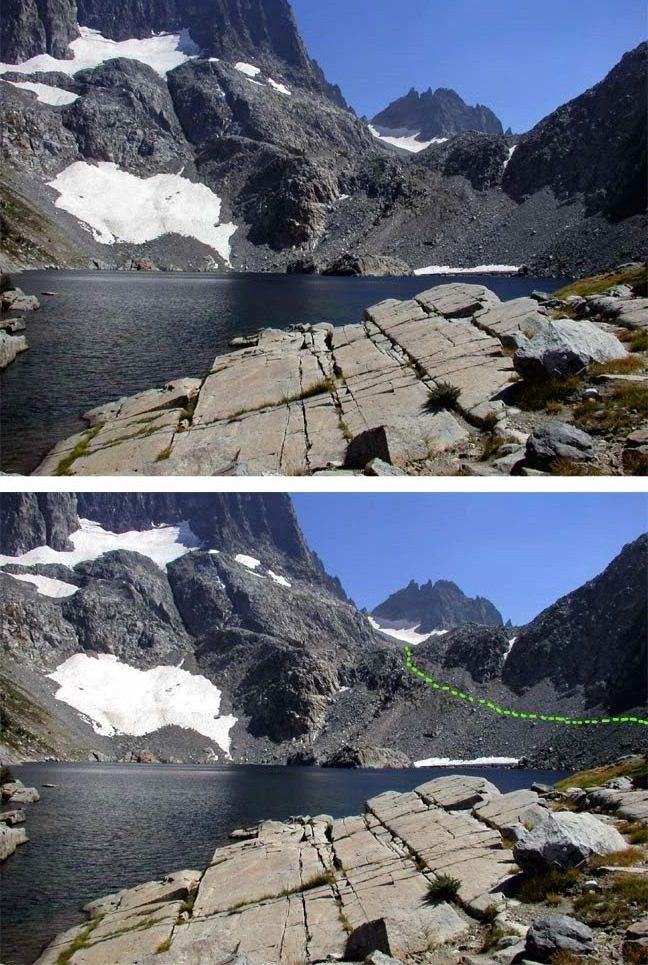
Cecile Lake was described as “windswept” in the “Sierra North” book, and she lived up to that description.
This writer was almost blown over during the first few minutes of our walk along the lake. We had two
choices for getting around Cecile: the “easier but longer” route was to the right. The “shorter but harder”
route was to the left, and involved another boulder dash. It was this route that we chose, and I think our
group would not make the same decision again. We’d already trekked 2.5 or 3 miles to that point, some of it
over loose rock, and the fatigue was evident in the many missteps and ankle-rolls this writer endured along
the broken shore of Cecile. After finally reaching the south end of the lake, we stopped for lunch (same fare
as before, with the substitution of Underwood’s deviled chicken for tuna for this writer). The wind blew
various objects and articles of clothing, but we recovered everything. We discussed the trail ahead of us,
which was expected to have the same treachery as our ascent from Iceberg, but only in reverse.
After walking below Cecile for less than a quarter mile, we came to a crest from which we could see our destination, Minaret Lake, Mammoth valley beyond that, and a further range of mountains in the distance. A
gorgeous panorama, if it weren’t for the vertical drop in front of us, which we needed to descend. A hang
glider would have been the vehicle of choice, but none of us had thought to pack one. The route was again
invisible. Charles thought he discovered it, but Andrei and this writer are certain it would have led to our
deaths (or, more likely, a retreat back up the mountain) had we proceeded. With some help from “Sierra
North,” we headed to the east (left) edge of the crest. Andrei spotted a “duck,” which is a stack of rocks left
by prior (successful) backpackers to mark the way. Even so, there was no way to walk down; the incline of
the mountainside forbade it. We took off our packs and attached them via carabiner to a length of climber’s
harness (which we used as rope), and lowered them one at a time down to Andrei, who had climbed to a
shelf below. Once all the packs and their owners had made it down to the ledge, we walked with relative
ease along a generously wide (and therefore reassuring) outcropping in the rocks; a sort of “high mountain
plateau” that delivered us to the canyon below.
The canyon was green – from healthy soft grass to abundant shrubs and numerous stands of trees, with
occasional bursts of wildflowers to punctuate the spectacle. “The Sound of Music” is a good reference point.
The canyon, with the view of an easy walk to Minaret Lake beyond, was a perfect place for a rest, and this
writer hopes never to forget lounging in the soft grass, enjoying a few moments of well-deserved rest to
recount the day’s victories. From here we made the last easy walk down to Minaret Lake to explore the
campsites we had spied from the crest above. We selected the second of these sites, located at the base of
the large peninsula that dissects the lake, forming the latter into the shape of a kidney bean (and presumably
a kidney?).
The Descent to Minaret Lake
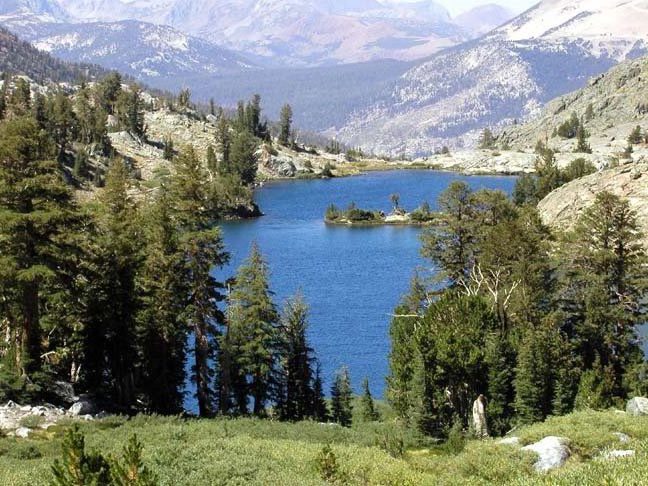
Our site has been repeatedly referred to (by our group) as the finest site any of us has occupied, or at least
“one of the best.” The peninsula is a large one and has a nice-sized hill on it, such that our camp was well
protected from the remaining but dying winds. It had a nice hearth, previously used as a fireplace for nondraught
season, but used by us as a place to rest our camp stoves. [As I continue to write, Charles has just
caught and released his second fish, this one a small rainbow trout.] The site for our tent was level and
somewhat sandy – perfect for high-mountain sleeping. Our predecessors, obviously master engineers in their
own right, had fashioned a rather comfortable tree-chair, by placing a large, flat rock (the size of a generous
stepping stone) in the gnarled base of a tree that split into multiple trunks. Because of its semblance to a
throne, we called it the “chair of knowledge,” and it was from there that all important decisions were made.
The walk down to the lake was short (100 feet), so our water supply was secured. We also had our own
beach, where we napped on soft grass, and our own meadow situated below the campsite itself, with a log
and stones as if for entertaining guests. It was here that we had our lunch. And, as described earlier, our
camp and the entire basin was surrounded by the Minarets, a final touch of beauty to complete our home (for
two nights, anyway). It was quite a campsite.
The moon appeared in the late afternoon, and we enjoyed its long waltz across the sky above the Minarets
each dusk. The sun, too, put on a show at the end of each day, hiding behind the ominous “Clyde Minaret”
(each major promontory of the Minarets has its own name), casting angelic sunbeams from either side of
Clyde’s a-shaped peak. We walked up the hill behind our camp, along the peninsula towards the center of
the lake, where we watched the dulling glow of the waning sun give new color to the Minaret basin. Dinner
was again freeze-dried food, but we were all impressed. Andrei recommends the “teriyaki chicken with rice,” while Charles and this writer favored the lasagna, which was better than lasagna from some restaurants.
This writer actually stayed awake to see stars! And what a show it was. The universe never seems to
disappoint.
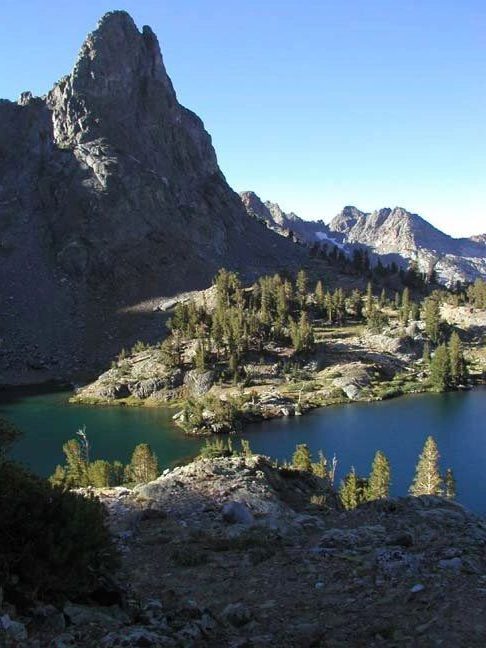
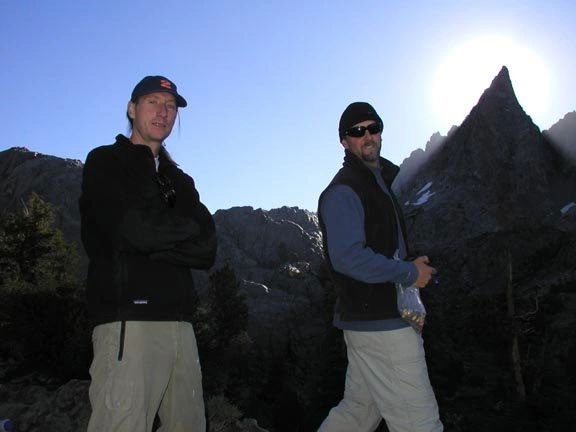
Day 3: Layover at Minaret Lake
Much of our site at Minaret Lake has been described, but let me further add that this has been the finest day
spent on a backpacking trip that this writer has encountered (although in all honesty this statement likely
appears in other logs penned by this writer). The day is drawing, sadly, to an end, so I will try to capsulate
our convalescence briefly.
We emerged from the tent at 8:00, and had a leisurely breakfast. From there we walked to the tip of the
peninsula, and then onto a tiny island which almost, but not quite, bridges the remaining channel that
connects the two halves of the lake. There we relaxed and watched Charles fish.
I slowly began to have a realization that it would be a travesty if we did not pay homage to our “Tom Sawyer”
day by taking off our clothes and jumping into the lake’s cool waters. Andrei and I discussed this probable
eventuality. Charles was intent on his fishing, so much of the deliberation was conducted without his
participation. After first making a pact that no photographs of full frontal nudity would be tolerated, first I
succumbed to the water’s siren call. It was cold, to be sure, but not excessively so. Andrei followed, and
then Charles (punctuated with an expletive… which in context meant to explain “I’m doing this because both
of you did it, and not because I want to”). After a few moments of shivering, the sun’s rays prevailed, and we
sat there, on an island, in the middle of the lake, as nude as we were the day we were born, for all to see. It
was refreshing for the soul, and I would venture to speculate that we all smelled a bit less offensive as a
result.
There isn’t much to write about the rest of the day that hasn’t already been written. Charles fished. Andrei
walked (a complete circuit of the lake). This writer compiled these thoughts. We all relaxed on the cool grass
of our private beach, and we had lunch in our private meadow, on the log that served as our bench and the
stones that served as our table. This writer is rather pleased with his tuna creation, which involved sweet and
spicy tuna, with a packet of mayo and a packet of Taco Bell “fire” hot sauce, and the juice of half a lime. All
spread on a bagel, of course. The other half of the lime squeezed into this writer’s water jug made a delicious
beverage, as did the hot tea and cherry brandy we enjoyed.
Of note, we saw NO mosquitoes during the entire trip, which added to the perfection of our stay. As I write
these final words for the day, some other backpackers (two of them female!) have also skinny-dipped,
perhaps for our viewing pleasure, but more likely for their own concerns of Tom Sawyer, Becky Thatcher, and
hygiene. Whatever the inspiration, their water adventure occurred a safe distance, so as to keep the
spectacle G-rated, or perhaps PG.
One final note as explanation for the copious use of limes at lunch: our stash of limes outlasted our stash of
tequila. And now, off to supper.
Dinner consisted of freeze-dried (of course) “Chili Mac” and beef stroganoff. We noticed that the
“Backpackers Pantry” products were not as good as the “Mountain Haus” products, and, as Charles astutely
noted, require more water to make. After dinner, we had a little brandy and some gourmet Swiss chocolate,
and headed out for a walk. We went to the “other half” of the lake, and sat on a big rock overlooking the lake
and its outlet. As the dusk’s light faded, we saw a few bats appear, and we watched them hunting insects in the darkening sky. Once in a while, a bat would come a little too close for comfort, perhaps prompted by
Charles’ flash photography. It was during these close calls that Andrei would tell us about obligatory rabies
shots following even the most insignificant and transient contact between humans and bats. I had my
windbreaker draped over my head, not to ward off the weather (which remained pleasant), but to avoid an
evening hike to Mammoth for a rabies shot. Of course, nothing came of the bats, except for some quality
high-mountain entertainment. When we’d had enough of the bats (and enough of the Red Man chewing
tobacco), we walked back to camp, to turn in four out last time in this valley of Sierran wonder.
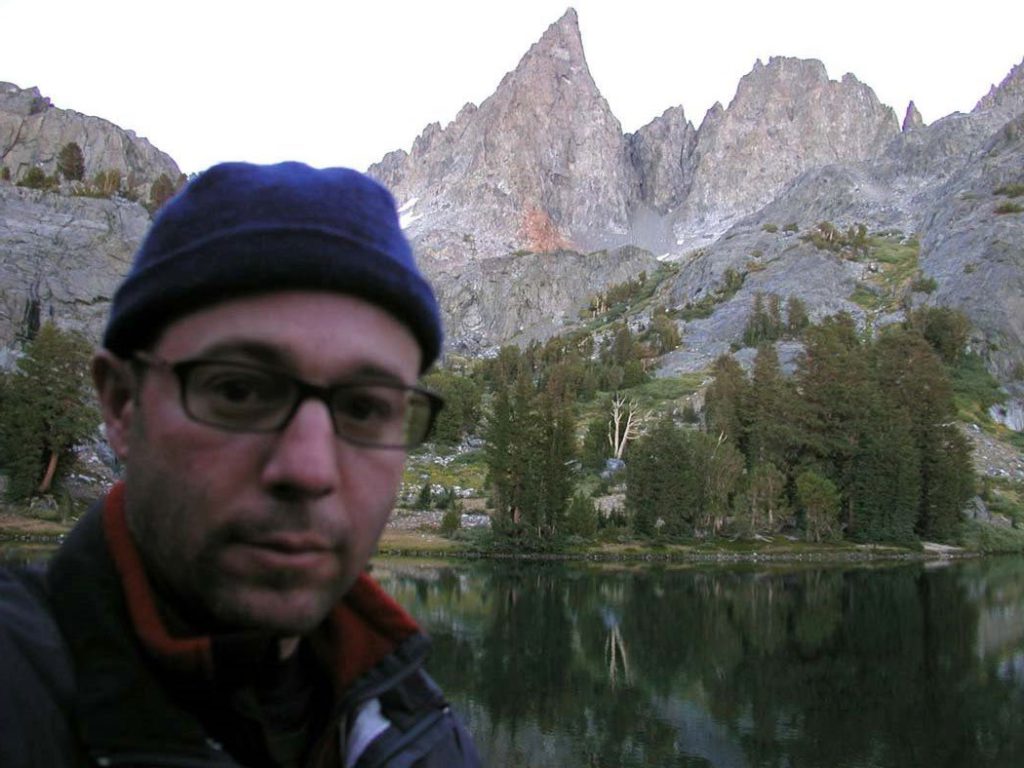
Day 4: The Journey Home
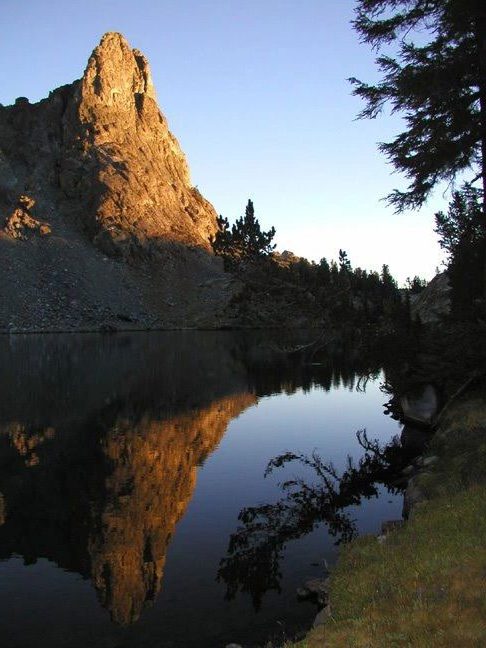
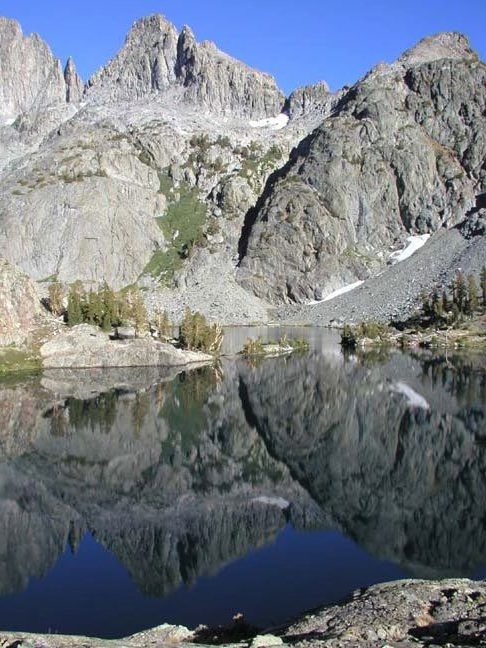
Beneath The Minarets
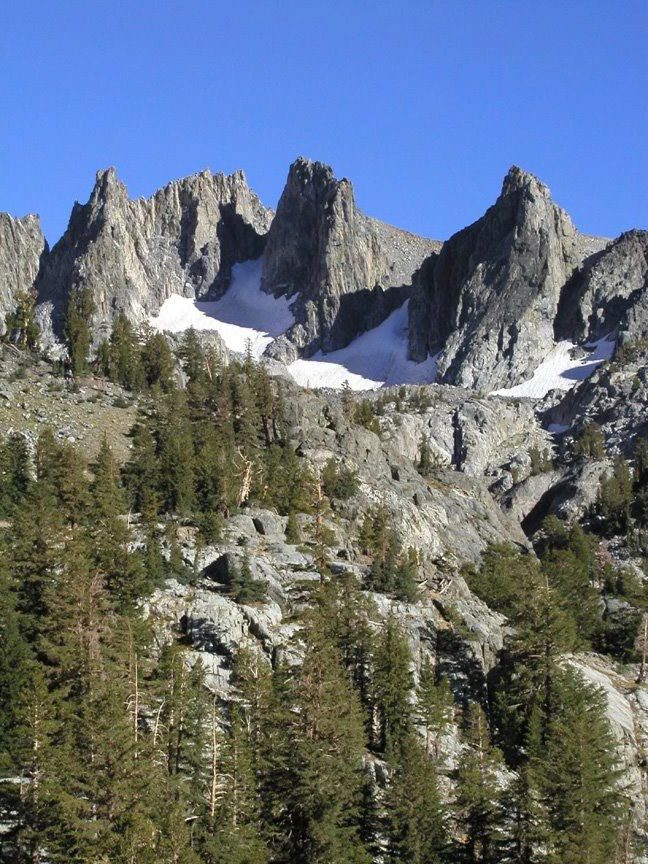
The Descent to the Devil’s Postpile
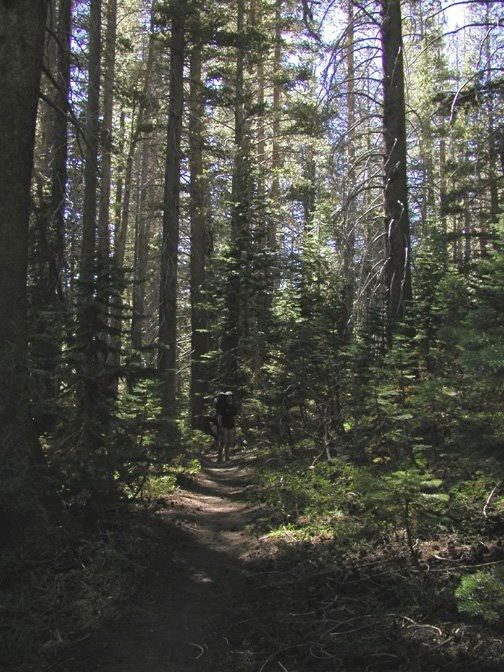
Unfortunately, the trail came to an end, as all trails do, and we were deposited at our car at 12:30, where cold
beer awaited us in the ice chest deposited in the trailhead bear box by Andrei four days prior. It was a
welcome drink, and it perhaps served as a celebratory buffer, accentuating the transition from our “old” lives
in the mountains, to our “new” ones in civilization. But to call our civilized existences “new” certainly is
inaccurate – not a day or even an hour went by that we did not think fondly of our loved ones, with stories of
our wives, children, and extended families always a part of the days’ conversations.
After a splendid lunch at the “Base Camp” restaurant in Mammoth, it was back into the cars and back to our
families – to whom we are all excited to tell this story, or at least one like it.
Epilogue
Details are always forgotten when stories are reduced to a journal, and this log has been no exception. Here is one of those forgotten, or almost forgotten, fragments. Charles implored that I add a reference to Andrei’s “sardine mishap,” where, during our lunch on Day 1, on the shores of beautiful Shadow Lake, Andrei accidentally poured some sardine oil out of the tin of sardines and into his boot. I can’t say that the mishap caused too much damage, but then again I can’t say I made it a point to smell Andrei’s boot, either.